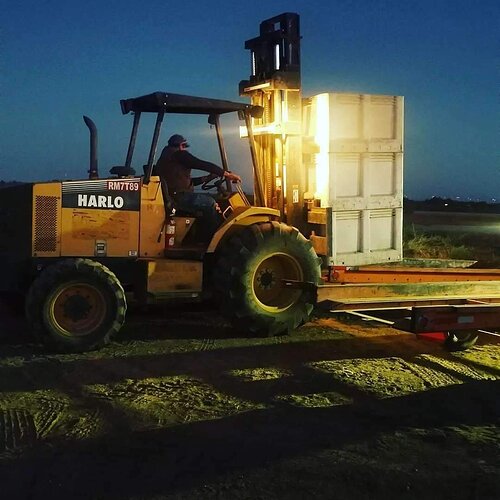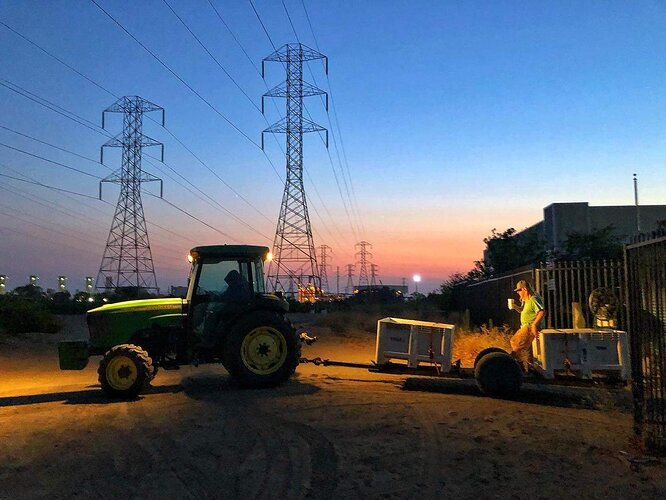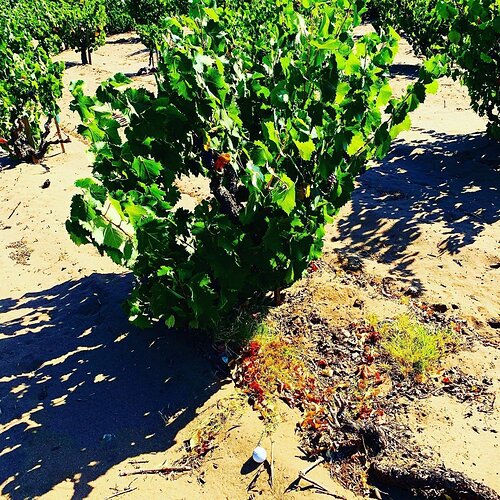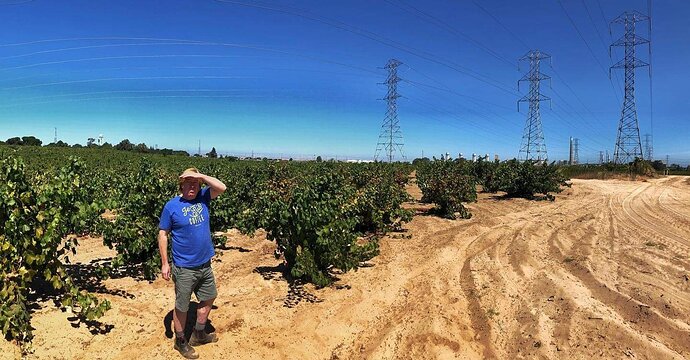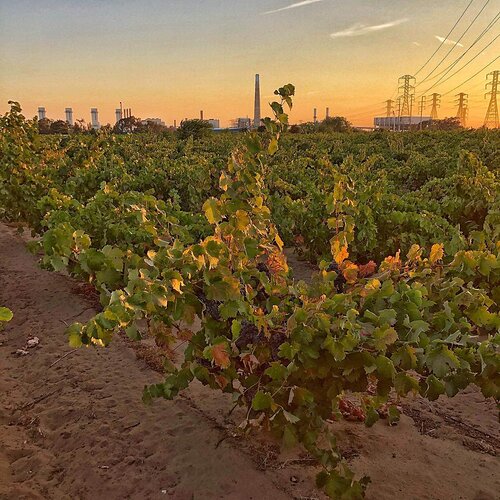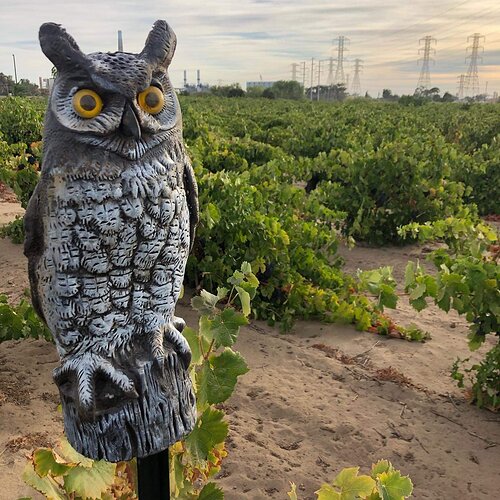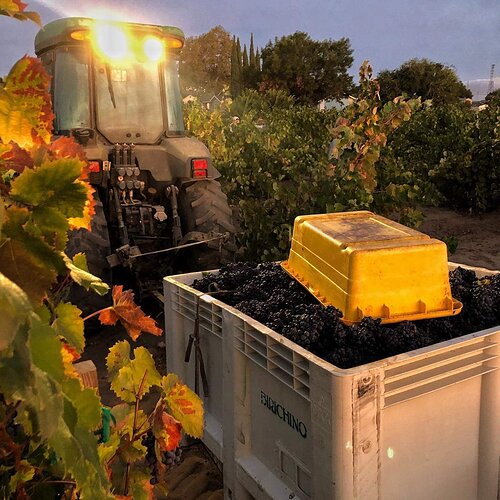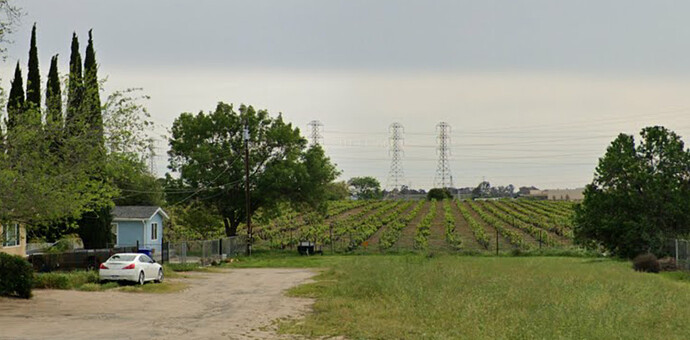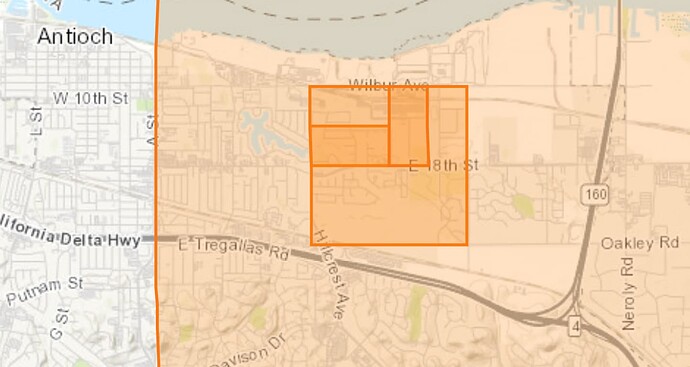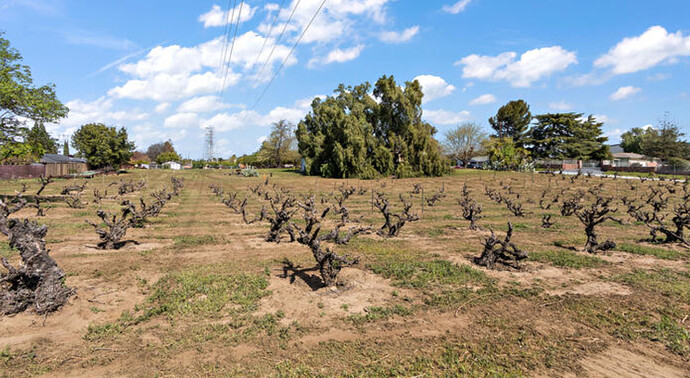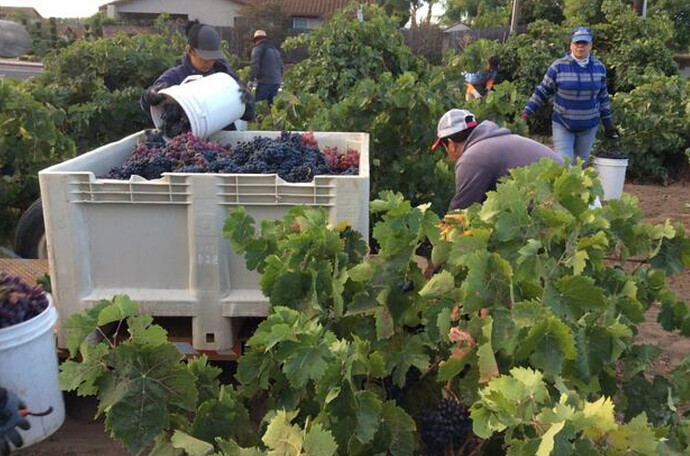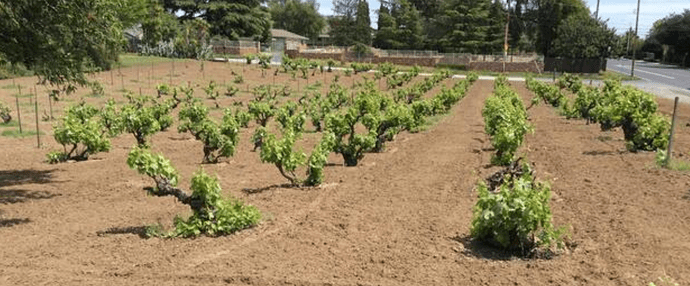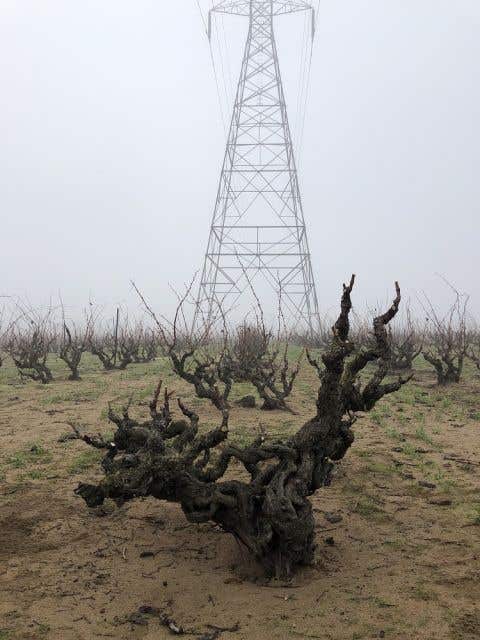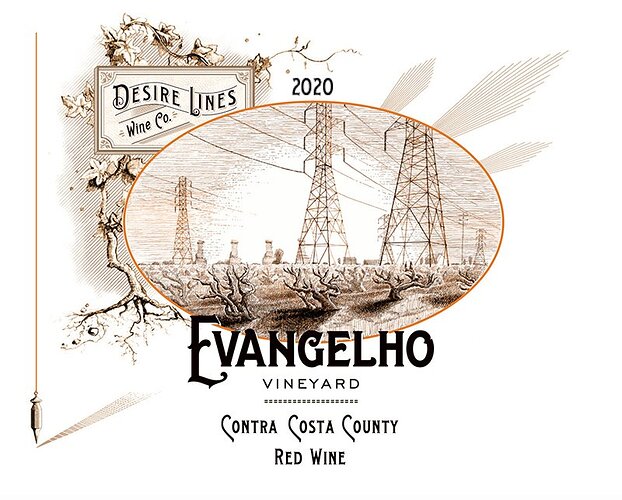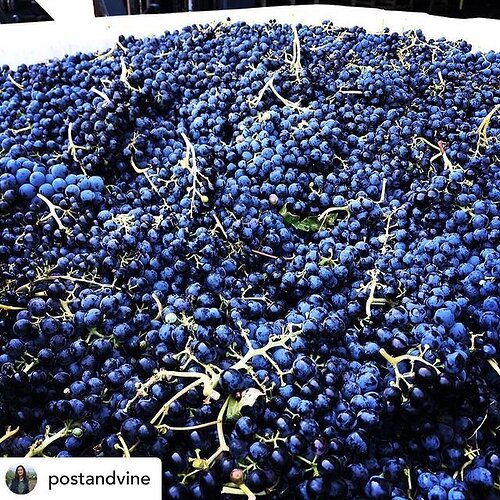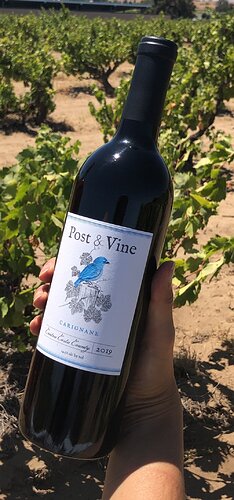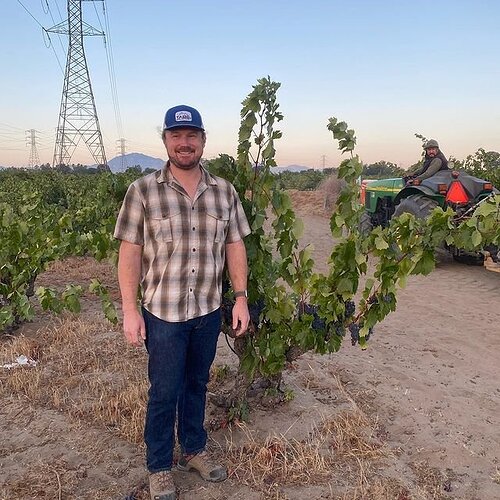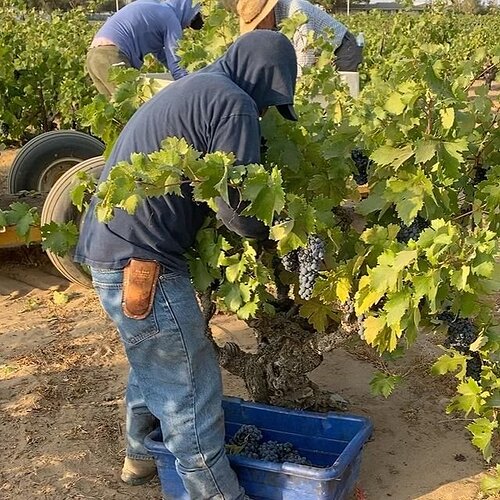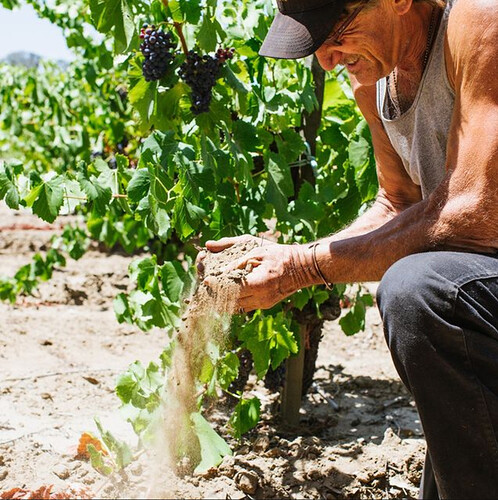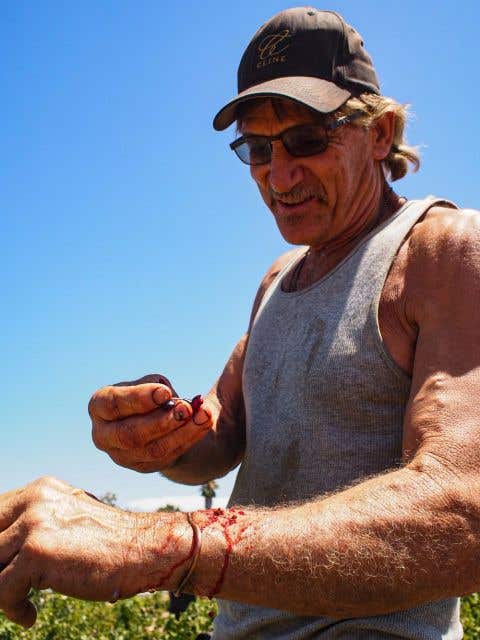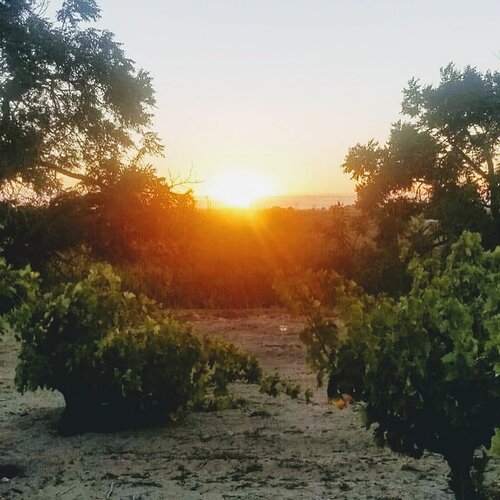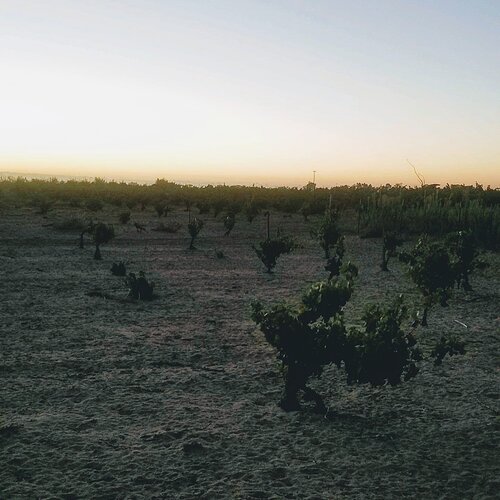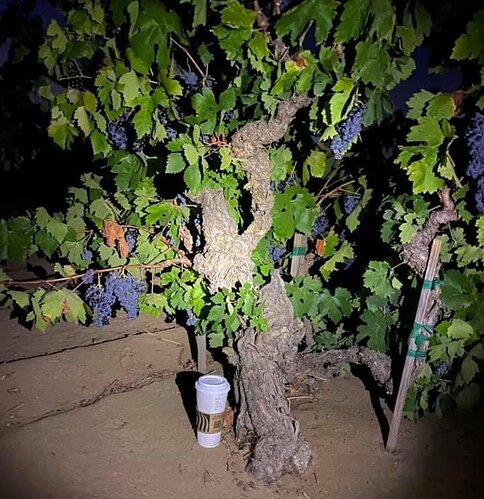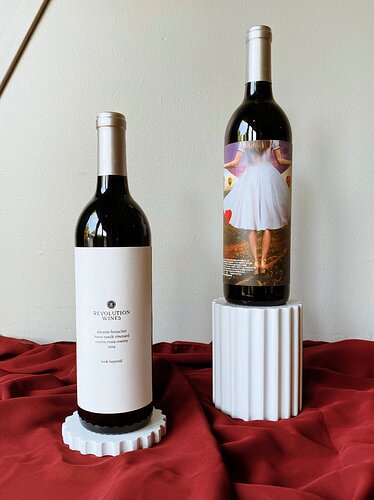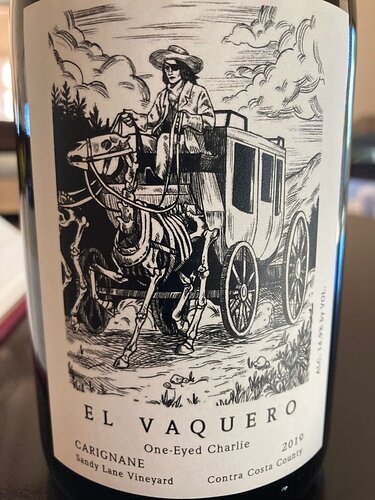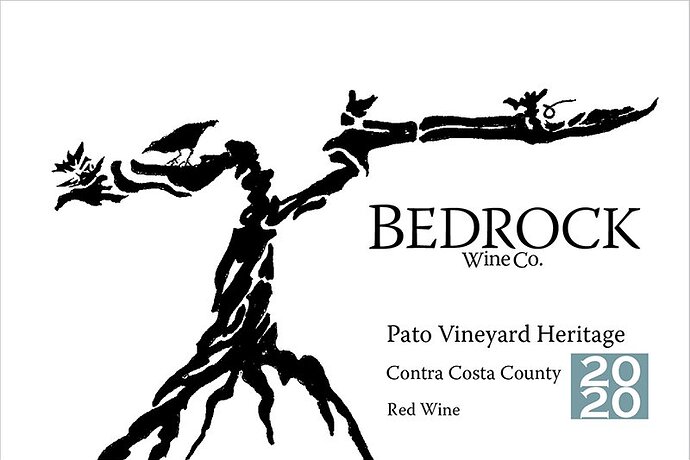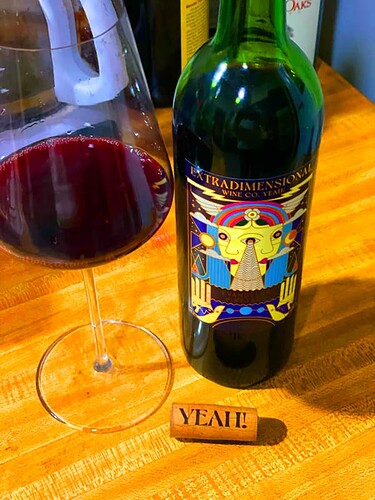Favalora Vineyard & Winery Facebook video
September 3, 2021
“Sophia Favalora Vineyard Night Harvest”
In the cool darkness, Carignan grapes were harvested today from the “JJ Vineyard” in Oakley, CA, for Three Wine Company:*
Note: The “JJ (Joaquin Jose) Vineyard” is also known as the “Dutch Slough” or “Emerson Vineyard”.
Three Wine Company website:
https://threewinecompany.com/
PART 1 (of 2): Birichino is celebrated for sourcing some of the highest quality old-growth Santa Clara and Santa Cruz fruit.
However, its single-vineyard Mourvèdre bottlings are made from eastern Contra Costa County. These images are from the winery’s Facebook page:
The August 11th post features a snapshot taken in the hours preceding harvesting Antioch, CA, grapes for the red wine:
The August 5th post states that fruit picked around this date is destined for the winery’s Rosé. The “Little Big Block Vineyard’s” vines are from circa 1895. These proprietary site-names are killin’ me!
From Birichino’s August, 2019, Rosé grape harvest in Antioch:
In PART 2, I will share some muddled thoughts on this producer’s Mourvèdre bottling - specifically the obfuscation of its provenance.
Birichino website:
https://www.birichino.com
PART 2 of 2: From 2015 to 2017, Birichino’s Contra Costa County Mourvèdre wines were from an old-vine, own-rooted planting that included Carignan and Zinfandel. Another ancient CoCo vineyard became the source for Birichino’s Mourvèdre grapes in 2019.
The data sheet for Birichino’s 2017 vintage Mourvèdre states that the former CoCo fruit source is situated in a swale, which allegedly provides vines with a measure of protection from excessive heat.
The 2015-2017 vintages of Birichino’s Contra Costa Mourvèdre may have come from the Gonsalves family’s “Sandy Lane Vineyard” in Oakley, but there isn’t sufficient info available to be sure.
In 2019, Birichino began sourcing Mourvèdre from a small old-vine parcel adjacent to Antioch’s legendary “Evangelho Vineyard”. Photos taken of the vines make this apparent: power lines and smokestacks are found in the immediate background.
Initially, it was a challenge determining whether the “Little Big Block Vineyard” was the same as the Sandy Lanes Poperties/Gonsalves family’s Antioch property (immediately West of “Evangelho Vyd”, as shown in the map at the bottom of this post).
A Google Maps street view does appear to confirm this suspicion. Tall ornamental trees appear in both the street view and one of Birichino’s Facebook photos.
I am now fairly certain the NE Antioch parcel that Birichino harvested grapes from belongs to the Gonsalves family. According to posts on the winery’s Facebook page, this land was planted c.1895. The vines are own-rooted and head-trained.
** EDIT ** Additional Info:
There exists the additional possibility that Birichino is sourcing fruit from two non-contiguous Sandy Lane properties, each North of E 18th Street in Antioch, separated by a PG&E easement and Vineyard Lane.
· “Little Big Block Vineyard”? - map shown at bottom of post
· “Sand Pit / Driving Range Vineyard” - 2901 E 18th Sreet / 1699 Vineyard Lane, Antioch
Point2Homes
Lee & Associates Commercial Real Estate Services
2901 E 18th Street / 1699 Vineyard Lane
Realtor Flyer (PDF download):
2901 E 18th Sreet / 1699 Vineyard Lane
If the “Little Big Block Vineyard” is ~26 acres, and the “Driving Range / Sand Pit Vineyard” is 12 acres, then their locations should be the opposite of what is indicated above.
To further muddle things, a 2020 CoCo Ag document indicates that Dan and Gary Gonsalves each farm different plantings on the Northwest side of Vineyard Drive in Antioch:
· “Big Vineyard / Vineyard Lane” parcel: 26 acres planted
· “Driving Range” parcel: 12 acres planted
History:
100 years ago, the Viera, Trembath, and Bigelow families were early grape-growers in the Antioch and Oakley area. Joseph Ruckstuhl owned a large vineyard in what is now northwest Oakley, to the East of Antioch Bridge.
Image: “Trembath 1874 Parcels”
Note: The Trembath family’s two rectangular land holdings were located to the West of the Viera and Ruckstuhl properties.
The area encompassing the “Evangelho” and “Little Big Block” vineyards might have been planted by the Viera family in the late 1800s. It is certain that the Vieras owned the property when PG&E purchased certain parcels in 1952 to erect power lines.
Manuel Evangelho, father of Frank Evangelho, helped tend the Viera family’s farm for 20 years before purchasing 11 acres of vineland from them. He acquired another portion of the Viera Ranch shortly thereafter when he leased two adjacent parcels from PG&E, bringing the total to 29 acres of vine-bearing land under his care. Manuel farmed the vineyard from 1930s until 1963, passed away sometime after; his wife Mary Evangelho in 2003.
From 1963 until his death in 2018, Manuel’s son Frank helped establish the “Evangelho Vineyard’s” reputation across California. Today, Bedrock Wine Company owns the “Evangelho Vineyard”.
Birichino website:
https://www.birichino.com
In March of 2019, I wrote that Vasco Urbano / Nottingham Cellars of Livermore Valley had bottled a single-vineyard Carignan from an ancient planting in Antioch. The “Trembath Vineyard” was an unfamiliar vineyard designation, a real head-scratcher.
This morning, I found a realtor website devoted to a certain address on Trembath Lane. This site featured a Vimeo video profile of the property:
https://vimeo.com/530892578
Trembath Lane property website:
https://trembathlane.com/#!/
“Unique opportunity for urban farm and rare chance to continue one of the oldest vineyards of Carignan grapes in Contra Costa County and enjoy a heritage almond harvest! Two adjacent parcels with a combined acreage of almost 2.75 flat acres…”.
I think it is safe to say that the 2016 Vasco Urbano “Trembath Vineyard” Carignan was sourced from this particular old-vine, head-trained vineyard.
I hope that the eventual sale of this property does not portend the destruction of its grapevines.
The realtor website’s profile of the “Trembath Lane” states that this parcel has been owned by the same family since 1867!
According to Vasco Urbano’s Instagram post, the Carignan vines are over 130-years-old!
Vasco Urbano Instagram post link:
https://www.picuki.com/media/1872906142798016834
Vasco Urbano / Nottingham Cellars website:
https://www.nottinghamcellars.com/
Every year, Jancis Robinson’s website hosts a writing contest on different eonocentric topics, accepting submissions from the general public. 2021’s theme is focused on “old vine” plantings.
Though much of the content on the Jancis Robinson website remains behind a paywall, the final selections from each annual wine writing contest are freely available to the general public.
One contestant’s piece is dedicated to Contra Costa’s most prized ancient vineyard: the “Evangelho Vineyard” of Antioch.
Jancis Robinson
“WWC21: ‘Evangelho - The Vineyard at the End of the World’”
by Chris Howard
August 30, 2021
It appears that Mr Jake Neustadt, Viticulturalist Supreme of Bedrock Wine Company, shared several insights with the essay’s author. The “Evangelho Vineyard” is, most significantly, a living example of pre-phylloxera farming practices.
The passage of time reveals this vineyard’s relative strengths and weaknesses. 130-years of life testify to grapevines’ ability to endure adverse weather events and diseases/pests pressure.
Vigilant supervision, agricultural maintenance strategies, and conscientious interventions are needed to preserve these vines. A booming suburban population also threatens the old-growth vineyards of Antioch (and Oakley).
Please view the hand-sketched “Evangelho Vineyard” Grid Maps available on the JR WWC21 webpage
-
Key for Grape Varieties: Link
-
Evangelho Grid Map #1 (complete vineyard): Link
-
Evangelho Grid Map #2 (Block 5): Link
Though the above images accompanied Chris Howard’s WWC21 submission, and are posted on the Jancis Robinson website, I believe that the identification, charting, and creation of the “Evangelho Vineyard” grid maps were the sole work of Jake Neustadt and Bedrock Wine Company.
Image: “‘Evangelho’ vines and power lines looming up out of the fog” (Chris Howard submission on Jancis Robinson website)
Desire Lines’ 2021 Fall Release includes the 2020 vintage of their “Evangelho Vineyard” Red Wine for mailing list members:
"2020 ‘Evangelho Vineyard’ Red Wine:
“Our 2020 Evangelho Red Wine sits between the zesty 2018 and (modestly) richer 2019, stylistically – linear and fresh like the 2018 but a touch silkier on the palate, with a hint of the fruit sweetness and youthful exuberance that characterizes the 2019. As in previous vintages, the wine was fermented with 30% whole cluster under a submerged cap and aged for ten months in neutral 400L barrels. As I’ve said before, I love the 400L barrel size for Carignan – it retains freshness and builds tension like all large format barrels, but with a less reductive tendency than the 500L and 600L barrels that I prefer for Syrah and Mourvèdre. The Carignan gives the wine a singular juiciness and floral and red-fruit aromas, with a soft tannin profile and vibrant acidity. The inclusion of cluster adds spice to the nose, while the small portion of carbonic maceration and Mourvèdre add flesh to the palate. We model our winemaking after the great cru Beaujolais - wines that are delightful when young but age beautifully as well.”
Winery website: “Evangelho Vineyard”
Bedrock Conversations Podcast
Episode #21: “Cody & Emily Rasmussen, Desire Lines”
Alternate Link
"Husband and wife duo, Cody Rasmussen (Associate Winemaker, Bedrock & Owner, Desire Lines) and Emily Rasmussen (Owner, Desire Lines) discuss their Californian origin story, the early days of Bedrock, and their upcoming Fall release for their own label, Desire Lines.
" 01:24:10 - 2020 Evangelho Red Wine "
Desire Lines Wines website:
https://desirelineswines.com/
Post & Vine, a joint venture between Rebekah Wineburg and Erica Kincaid, has released its first red wine from Contra Costa County. This small producer originally bottled a single wine: a field blend from Mendocino’s “Testa Vineyard”. A Rosé from “Sandy Lane Vineyard” Carignan(e) was launched a few years afterwards.
from the 2021 Fall Release email:
“…A spirit of curiosity compelled us to search out other historic vineyards with old vine Carignane to learn more about how this variety expresses place. We are now ready to share the result of that investigation with you with our newest wine, the 2019 Post & Vine Contra Costa Carignane. From the ‘Sandy Lane Vineyard’, the same source as our Rosé of Carignane, this small production wine is bright and juicy with a thirst-quenching acidity…”.
"2019 Post & Vine Contra Costa Carignane
"Bright and fruity with a little spice, the 2019 Post & Vine Contra Costa Carignane is engaging and vibrant. Raspberry, blackberry and plummy fruit combine with fresh aromas of crushed rock and earthy spice followed by hints of violets and a silky texture. Lighter in body than the ‘Testa Vineyard’ Old Vine Field Blend, and made from 120-year-old vines planted in the sandy soils of Contra Costa, this wine is fun and fresh and can be served slightly chilled.
“72 cases produced”
Post and Vine website:
David Gates of Ridge Vineyards posted the following images on his Instagram page last month:
According to one of Mr Gates’ posts, the 2021 harvest in Antioch was down by about 50% in yields, as the East Bay has been throttled by two years of severe drought.
Ridge has bottled only a handful of wines from CoCo grapes over the past 3 decades. A vineyard-designate from “Evangelho” - spelled “Evangelo” - was produced from 1990 to 1993 (primarily Mataro). The “Bridgehead Vyd” in Oakley provided grapes for a single-vineyard Mataro from 1993 through 1997(?).
In 2018, Ridge returned to the area, and released two old-vine wines: “Evangelho Vyd” Zinfandel/Carignan/Mataro blend and “Gonsalves Vyd” Mataro. In 2019, the “Evangelho” red was primarily Carignan w/Zin, and the “Gonzalves” was Carignan.
I am not certain whether the “Gonsalves/Sandy Lane Vyd” Carignan will be offered again following the 2018 and '19 vintages.
Ridge Vineyards website:
On more than one occasion, I have written about how the City of Oakley contracted local grower Alan Lucchesi to excavate and replant a threatened parcel of ancient grapevines in order to guarantee their continued survival.
Christina Rasmussen, owner of Little Wine, wrote an essay on the Oakley Vineyard Transplant Project for Jancis Robinson’s 2021 Wine Writing Contest.
In “Alan’s Alicante”, author Christina Rasmussen details how local vineyard owner and manager Alan Lucchesi and his team went about digging up, transporting, and replanting 2,300 teinturier grapevines.
Jancis Robinson
“WWC21: Alan’s Alicante, California”
by Christina Rasmussen
August 26, 2021
"…Alan [Lucchesi], I discovered, is one of the farmers whose family has been tending vines for decades. In the 1930s, his grandparents emigrated to the United States from Lucca, Tuscany. They bought some land in Oakley, where they planted grapevines, almonds and apricots…It was in 1982 that Fred Cline, one of the grandchildren of Valeriano Jacuzzi, set up Cline Cellars…At the same time, Alan Lucchesi had begun taking the reins from his parents. Alan reflected:
“‘I began working for Fred in 1990; I was just helping him to man a few fields around here, and then I also started to sell some grapes to him. At first, it was just Fred, but soon after Bonny Doon and Ridge started coming into the area.’
“In addition to planting new vineyards in the 90s, Alan also safeguarded the old vines, and leased other vineyards. Today, he farms 700 acres. This might sound like a lot, but it’s estimated that the vineyard plantings of Oakley have diminished by two thirds over the past 100 years, with half of the region’s vineyards having been ripped up since 1980…”.
The author learns how centennarian grape vines were reestablished, in the “Walnut Meadows Vineyard”, a few hundred yards from their original home. Alan Lucchesi relates the circumstances that required uprooting over 2,000 Alicante Bouschet vines, as well as the steps taken by mayor Kevin Romick and city council members to protect the vines.
"…In early March 2011, Alan and a group of fellow workers dug up the 2,300 sleeping beauty Alicante Bouschet vines.
“‘You have to transplant around March - not while they’re growing, or they’ll never make it. You have to do it when they’re still sleeping.’
"Using backhoes, they took the vines out of their original home, and drove them 1.5 miles down the road to their new home—a narrow five-acre patch of land right next to a new housing development. Incredibly, when it came to replanting the vines, the ten-foot holes were dug by hand.
"…The vines’ root systems were between 15 and 20 feet long. As it would have been almost impossible to dig 20-foot holes, some roots had to be trimmed a bit shorter; not all that dissimilar to trimming roots when you receive plants from the nursery.
“‘That’s okay. They still take off. The feeder roots sit higher, and all of the main root balls were still there. It’s the vines themselves that are now 115-years-old, after all. We dug by hand because you need to make sure the vines fit right. You can’t just squish them in, because the roots are all different sizes; like spider legs; you need to dig around them and turn the vines around in the hole. And it’s pretty easy to dig sand, it’s not like hard dirt. You dig that hole pretty fast.’
"…He added that aside from being watered when planted, they are unirrigated, and organically tended.
“‘What was the rate of survival?’ I wondered.
“‘I don’t think we lost a single vine’…".
The City of Oakley originally contracted the vineyard transplant because a power substation was slated to be built where the vines first grew.
In 2007, Antioch’s “Evangelho Vineyard” had lost a parcel of 1,000 vines due to the demands of area growth.
Ironically, in both cases, the infrastructure plans ended up being cancelled!
More on Oakley’s Vineyard Transplant Project:
Wine Berserkers
“Saving Old Vineyards - Economic vs Heritage” thread
Early thread entry about transplantation / “Walnut Oaks Vineyard”
March 7, 2018
“Saving Old Vineyards - Economic vs Heritage” thread
“Vine Transplantation - 10 Years Later?”
August 4, 2021
delete
Looking at other photos posted to social media later the same day, I believe that the “JJ Vineyard” is the same site as the “José/Emerson/Lucchesi Vineyard”, located within the Dutch Slough Preserve.
The “JJ” in “JJ Vineyard” likely stands for “Joaquin José”, an Oakley citizen credited with establishing the vineyard over 100 years ago:
from “‘Lucchesi Vineyard’ @ Oakley’s Dutch Slough Preserve”, posted on June 14, 2021
“…The Vineyard with 3 Names:
· ‘Lucchesi Vineyard’ - Three Wine Company pays homage to area vineyard manager and grower Alan Lucchesi by evoking his name on Carignan bottlings from the Dutch Slough vines;
· ‘Emerson Vineyard’ - City of Oakley documents reference the Emerson family, historic cattle/dairy farmers and previous owners of 1/3 portion Dutch Slough Preserve which included the vineyard;
· ‘José Vineyard’ - Local citizens occasionally use the name of Joaquin José, who is said to have planted the site, to refer to the vineyard.”
Three Wine Company has bottled a single-vineyard “Lucchesi Vineyard” Carignan from this 13 acre, own-rooted site for several years.
In 2014, a Carignan was produced from the “Bigelow Vineyard” on Neroly Rd instead. I do not know the reason for the switch.
Three Wine Company website:
The following is from a Wilson Foreigner email sent today. The winery has produced a vineyard-designated Zinfandel from Contra Costa County for several years.
"Our 2018 ‘Del Barba Vineyard’ Zinfandel was named one of the ‘Year’s Best Zinfandels and Mixed Blacks’ in [u]Wine & Spirits[/u] magazine (June 2020 issue). With less than 15 cases remaining, make sure to stock up for the upcoming holidays! Use code CHEERS to receive 40% off your purchase.
2018 Wilson Foreigner Zinfandel ‘Del Barba Vineyard’, Contra Costa County:
“Ripe fruit aromatics, juicy berry and stone fruit flavors, and a finely grained texture. Full of sunshine. Will pair with absolutely anything on your table this Fall. 230 cases produced, $32 per bottle.”
"91 Points [u]Wine & Spirits[/u]:
"‘Wilson Foreigner is a partnership between Napa-based David Wilson and “foreigner” Chris Alheit, a South African vintner. They’re sourcing fruit throughout northern California for several wines, including this one, from an Oakley vineyard planted in 1910 and managed by the same family for three generations. It is a delightful wine in its youth, crunchy in its sweet cherry and red plum flavors, emphasizing delicacy and charm over heat and power. It seems years from peak expression; cellar. (230 cases)’
— Patrick Comiskey, Senior Correspondent"
Wilson Foreigner website:
*** EDIT ***
The 2019 vintage of Wilson Foreigner’s Contra Costa Zin was released on November 3, 2021. These details are from the winery’s 2021 Release email:
"…2019 Wilson Foreigner Zinfandel, ‘Del Barba Vineyard’, Contra Costa County
"The Zinfandel comes from a historic vineyard site in Contra Costa County, owned and managed by the past four generations of the Del Barba family. The vines are own-rooted and growing in the deep granitic sands of Oakley near the San Joaquin and Sacramento River deltas.
"The 2019 season yielded beautifully uniform and even-ripening clusters of Zinfandel. Our parcel was harvested at dawn on the thirtieth of August. Fifteen percent of the fruit was left as whole cluster, while the balance was de-stemmed, all went in to a concrete fermenter. Fermentation occurred with ambient yeasts and the must was pressed seventeen days after harvest. Primary and malolactic fermentation finished in neutral French oak barrels, no additions were made except for sulfur dioxide, and the wine was bottled without any fining or filtration.
“The wine has delicate aromatics, ripe berry, dried herb, and powdered cacao characteristics, all framed by the finely grained texture that this vineyard shows every year…”.
Recently, Sonoma Valley’s Abbot’s Passage and Beauregard Vineyards/The Lost Weekend (Santa Cruz Mountains) each have released bottlings from old-growth Contra Costa vineyards. Unfortunately, producers often are reluctant to identify their fruit sources.
· Abbot’s Passage 2019 “Verdant Wild”
"The fruit for this wine was sourced from 100+ year-old vines of the historic Contra Costa AVA, where these verdant vines are rooted in well-drained, sandy soils. The grapes weather heat spikes during the day with cooling breezes of the Sacramento Delta & San Francisco Bay soothing them at night. This broad temperature shift allows the fruit an extended ripening period, leading to more balanced wines.
“This blend of Mourvèdre & Carignan delivers a beautiful brightness of dried cranberry and pomegranate, complimented by savory notes of forest floor & cedar that linger on the smooth, fine finish. After a five-day cold soak & 21-day maceration via gentle pumpovers, the wine was aged for 14 months in 35% new French oak.”
69% Mourvèdre, 31% Carignan
14.2% ABV
472 cases
Abbot’s Passage “Verdant Wild” Instagram post
Winery Link: Product - Abbots Passage
· Beauregard Vineyards 2020 Lost Weekend Field Blend
The winery website does not provide details on the vinification methods used in making this Contra Costa-sourced bottling, nor is a breakdown of its component varieties listed. Beauregard purchased Zinfandel, Carignan, and Mourvedre grapes from a 135-year-old vineyard. The Edible Monterey Bay article states that the grapes composing the Lost Weekend Field Blend, a second label from Beauregard Vineyards, were from the “Sandy Lane Vineyard”.
Wine Industry Advisor
“Beauregard Vineyards Embarks on 76th Harvest in the Santa Cruz Mountains”
September 1, 2021
Edible Monterey Bay
“Grape Harvest Begins on the Central Coast”
by Laura Ness
August 17, 2021
“…Among the first wineries in the region to bring in grapes for Harvest 2021 was Beauregard Vineyards for Ryan’s second label, The Lost Weekend. Beauregard trucked in gorgeous old vine Carignan and Mourvèdre from ‘Sandy Lane Vineyard’ in Contra Costa County on August 11, to make their Lost Weekend Rosé. It was a night pick and the photos were amazing. Tasting Room Manager, Michael Phillips, says, ‘We are also producing our Lost Weekend Red from that vineyard this year, which is an Old Vine Field Blend, based on Zinfandel, and coming in as soon as this week’…”.
Winery Link: Beauregard Vineyards - Products - 2020 Lost Weekend Old Vine Field Blend
Abbot’s Passage website:
https://www.abbotspassage.com/
Beauregard / The Lost Weekend website:
The “Horse Ranch Vineyard” in Antioch, CA, has been mentioned on this thread in the past. Revolution Winery & Kitchen’s 2019 Alicante Bouschet was sourced exclusively from this old-growth Contra Costa vineyard.
Revolution Wines 2019 Alicante Bouschet
"Vineyard Notes: Gary Gonsalves farms about 100 acres of grapes in Contra Costa County, many of them 100+ year old plantings of intermixed Carignane, Cinsault, Mourvedre, Petite Sirah, Grenache & Alicante Bouschet, among others.
"‘Horse Ranch Vineyard’ lies within the city of Antioch, less than a mile from the famous ‘Evangelho Vineyard’ & on the same dry sandy soil. It is a mixture of Mourvedre, Carignane & Alicante Bouschet planted around the turn of the 20th century. Alicante itself is an interesting grape - one of the few teinturier varieties, meaning the flesh of the grape is also red. This gives it an intensity of color that is hard to match.
"Cellar Notes: For the second year in a row, we brought in 1 ton of these grapes & used a no-intervention approach in our winemaking. The bunches were foot-treaded into a macrobin with no sulfur or any other additions for a natural fermentation. The wine reached dryness in 15 days & was pressed to tank 2 days later. It was then racked into neutral oak - again without additions - until May of 2021, when it was bottled with no filtration.
“Tasting Notes: A deep, dense wine with aromas of dark cherries, blackberry, coffee & dark chocolate, with grace notes of nutmeg & allspice. In the mouth, it is equally complex, with a juicy fruit attack, savory black olive notes & cocoa-like tannins on the finish.”
Instagram post highlighting the release of the 2019 “Horse Ranch Vyd” Alicante Bouschet: Link
Revolution Winery produces about 15 other bottlings, as well as various wines in cans. The “Horse Ranch Vyd” Ali Bou is currently its only Contra Costa County wine.
I have not determined the precise location of this vineyard.
Revolution Winery & Kitchen website:
With its Spring 2019 Release, Fine Disregard Wine Co. first launched a single-vineyard Contra Costa Mataro (Mourvèdre):
Fine Disregard has produced a couple of vintages of “Pato Vineyard” Mataro (Mourvèdre). On The Wine Makers podcast, Mike Schieffer shares how he and Kara Maraden gained access to this legendary old-vine site. He also discusses the difference between the “Pato Vyd” and vineyards in closer proximity to the Sacramento Delta:
The Wine Makers on Radio Misfits
Episode 176: Fine Disregard"
December 25, 2020
> At the 42-minute mark in the interview, Mike talks about the “Pato Vineyard” and Contra Costa Mataro.

The “Pato Vineyard”, named in honor of Rich Pato, is adjacent to Diablo Water District’s Randall-Bold Treatment Plant in Oakley, CA. The diminutive “Mori Vyd” is situated on the same city block. The “Planchon Vyd”, found across the street from the “Pato Vyd”, is immediately South of the SW corner of Laurel Rd and Empire Ave.
Historic Vineyard Society profile: "Pato Vineyard
Fine Disregard website:
James Kennedy’s “Contra Costa Vineyards” for Google Maps:
Below are several newer small-production wines created from Contra Costa County grapes:
· El Vaquero Winery:
https://www.elvaquerowinery.com/
- 2019 “One-Eyed Charlie” Carignane “Sandy Lane Vineyard” Contra Costa
Instagram/Picuki video clip: Link
· Jambe de Bois Wines:
https://www.jambedeboiswines.com/
- 2017 Mourvèdre Contra Costa, “Castanho Vineyard”
from the winery website’s “The Vineyards” page:
"‘Castanho Farms’
Elevation 92 ft
“The Contra Costa AVA is home to many generational family farms. Most of what you see are almond orchards, that is where the money is. The small amount of famers who choose to grow grapes are those with passion and commitment. Castanho Farms is a small family owned grape growing operation in Oakley, CA just south of the river delta. Grown in sand deposits 100 ft deep, ‘Castanho Vineyard’ has some of the oldest Mourvèdre vines in California. The warm weather helps the Mourvèdre ripen to its full potential, making delicious wine that tastes of dark cherries and pepper.”
> Note: The “Castanho Vineyard” was planted in 1981. I do not understand the above claim (i.e., “‘Castanho Vineyard’ has some of the oldest Mourvèdre vines in California”).
· McKahn Family Cellars:
https://mckahnfamilycellars.com/
- 2019 Carignane Contra Costa, “Sandy Lane Vineyard”
from the Data Sheet:
“…In August of 2019 I received a text message from a colleague of mine that an old-vine vineyard in Oakley, in far east Contra Costa County, had excess Carignane for sale. The vineyard’s name was ‘Sandy Lane’, and by reputation alone I was intrigued. I had never made Carignane before; or ‘Kerrigan’ as every Carignane grower in California calls it. There is countless acreage of it in the Languedoc in France, but in California it is much more scarce. This particular vineyard is over 100 years old and is planted on its own roots in deep sand. It’s impossible for me to explain how incredible it is to make wine from a vineyard that was planted so long ago. - Mike McKahn”
· Vin de California (VDC):
https://www.vdcwine.com/
-
2020 “Invent the Universe” ZED Barbera Contra Costa
-
2020 “Queen of the Galaxy” Barbera Contra Costa
Adam Vourvoulis’ Vin de California was featured in the March, 2021, issue of Food & Wine magazine.
· Wonderwerk LA:
https://www.wonderwerkla.com/
-
2018 “Free Your Mind”, 50% Carignan (Contra Costa) / 50% Riesling (Arroyo Seco)
-
2020 “Free Your Mind”, 50% Carignan / 50% Riesling
According to the winery website details for the 2020 vintage “Free Your Mind” bottling, the Carignan grapes were sourced from the “Sandy Lane Vineyard” in Antioch, while the Riesling came from the “Zabala Vineyard” in Arroyo Seco AVA.
· Zumo Wine:
https://www.zumowine.com
-
2020 “Phew II” Sauvignon Blanc Contra Costa, “Evina Vineyard”
-
2020 “Zumito Frizbee” Verdelho/Sauvignon Blanc Contra Costa, “Evina Vineyard”
“Zumito Frizbee” was produced from Verdelho juice pressed over the skins of Sauvignon Blanc grapes. The wine is packaged in 500ml crown-capped bottles.
Fellow Wine Berserker Ken Zinns first mentioned Zumo on this thread a couple of years ago. Tom Morgan’s “Evina Vineyard” in Knightsen, CA, is farmed according to sustainable practices. A brief profile of Zumo Wine can be found in an Imbibe! magazine article from November, 2019.
This is another example of the “Sandy Lane Vineyard” designation being applied to Gonsalves family (Sandy Lane Properties) viticultural sites that are NOT traditionally associated with this place-name.
In my humble opinion, confusion could be avoided if the “Sandy Lane Vineyard” name was used only to describe this old-growth vineyard.
Cellartracker link for El Vaquero label image: 2019 El Vaquero Carignane One-Eyed Charlie Sandy Lane Vineyard - CellarTracker
The Winter 2021 Release from Bedrock Wine Company includes the most recent “Pato Vineyard” field blend and “Evangelho Vineyard’s” reserve wine, “Areio e Vento e Amor”:
Bedrock Wine Company currently farms these two eastern Contra Costa vineyards. Details about the current offerings can be found in the latest Bedrock Wine Conversations podcast:
“Episode #24 - 2021 Winter Release”
November 7, 2021
· 50:51: 2020 “Pato Vineyard” Heritage Wine
· 58:57: 2020 “Evangelho” “Areio e Vento e Amor” Red
It is stated during the podcast that an ancient parcel of vines neighboring the “Evangelho Vyd” is slated to be uprooted. Contra Costa’s dwindling acreage continually erodes under the pressures of suburban sprawl (around the 51:53 minute-mark).
It is presumed that northeastern Antioch once was one large vineyard. As the surviving blocks now are divided between several landowners, this vast field of own-rooted vines is unlikely to endure intact.
2020 ‘Pato Vineyard’ Heritage Wine, Contra Costa County
“Planted in the early-1900s, ‘Pato Vineyard’ sits on the southern edge of the deep sands that define Oakley. One of the most historically famous vineyards in the area, we have been proud to be its current farming guardian since 2014. Always a darker, more richly fruited example of Oakley this year’s wine features a higher than typical level of Mataro/Mourvedre in the final blend as it was an exceptionally strong year for the variety at the site. As usual, a small amount of Petite Sirah adds a deep, dark but suave note to the final wine. Thanks to the supple structure imparted by the sandy soils, this wine can be enjoyed for its sheer delicious factor early on but will also reward some time in the cellar.”
According to MTP & Chris’ discussion on the 24th episode of the Bedrock Conversations podcast, roughly equal proportions of Mataro and Zinfandel make up the majority of the 2020 “Pato Vyd” red wine. This year’s blend consists of only 10% Petite Sirah, significantly less than in prior vintages.
The Zinfandel component of the 2020 bottling came from the “Mori Vineyard”, a miniscule planting located on the same piece of land as “Pato”. Both old-growth plots are leased from the Contra Costa Water District in Oakley, CA. Turley Cellars also sources fruit from the “Mori Vyd”, which is blended into the “Duarte Vyd” Zinfandel.
"2020 ‘Evangelho Vineyard’ ‘Areio e Vento e Amor,’ Contra Costa County
“Our ode to Frank Evangelho (which translates from Portuguese to ‘sand and wind and love’) is based around the most distinct block at ‘Evangelho Vineyard’. Planted on a west-facing slope of beach sand, the block is a field-blend of Mataro, Zinfandel, Carignan and Palomino and always makes a wine that we feel is the ‘essence’ of ‘Evangelho’ and this historic section of Contra Costa County more broadly. Fermented in a two-ton open-top tank with 40% whole-cluster and raised in puncheon and dem-muid the wine oozes with dark Mataro fruit and spice leavened by the sappiness of Zinfandel and crunch of Carignan. It was a particularly strong year for Mataro at ‘Evangelho’, and this wine showcases that nicely.”
The “Areio e Vento e Amor” red wine is produced from the most treasured section of the “Evangelho Vyd”. Only ~700 vines make up this Mourvèdre-heavy block. The winemaking protocols differ from those implemented in Bedrock’s “Evangelho” Heritage bottling. Manual punchdowns, rather than pumpovers, and the use of smaller barrels in the cellar result in a more structured and age-worthy interpretation of Contra Costa’s sunny, wind-swept sandscape.
Bedrock Wine Company website:
https://bedrockwineco.com/
Ridge Vineyards has released the 2019 vintage “Evangelho Vyd” red wine:
"2019 ‘Evangelho’ Red Wine
Contra Costa County
"(47% Carignane, 29% Zinfandel, 24% Mataro)
14.1% ABV "
“Winemaking Notes: Deep garnet red color with aromas of cherry, dried herbs, dusty mineral, and leather. Juicy red berries on entry, medium body, elegant tannins, and a spicy, long finish. JO (2/21)”
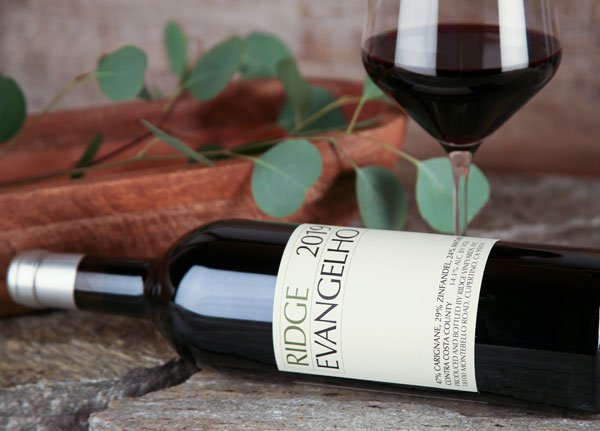
“Vintage Notes: The growing season began cool and wet but a mild, dry summer produced beautiful fruit from these 130-year-old vines. The Carignane and Zinfandel were harvested in late August. Mataro required more heat and days to ripen and was picked in early September. Fermented separately, the crushed grapes were pumped over twice a day for full extraction. The three varieties were then assembled by taste and aged eighteen months in barrel. Enjoyable now, the wine will develop further over the next eight to ten years. (1/21)”
“Growing Season:
Rainfall: 12 inches (below normal)
Bloom: Early May
Weather: Warm spring and hot summer days, with cooling afternoon Delta winds”
“Winemaking:
Harvest Dates: 23 August – 3 September
Grapes: Average Brix 23.0˚
TA: 6.68 g/L
pH: 3.33
Fermentation: 100% natural primary and secondary fermentation; 100% floating cap; pressed at eight days.
Barrels: 100% air-dried American oak barrels (100% Appalachia), 15% new, 26% four years-old, 33% five years-old, and 26% six years-old.
Aging: Eighteen months in barrel”
“‘Evangelho Vineyard’ grapes, hand-harvested; destemmed and crushed; fermented on the native yeasts, followed by full malolactic on the naturally occurring bacteria; oak from barrel aging; minimum effective sulfur; 35ppm at crush, 76ppm during aging. Pad filtered at bottling. In keeping with our philosophy of minimal intervention, this is the sum of our actions.”
"Press:
"OwenBargreen.com: 96 Points “The 2019 ‘Evangelho’ combines 47% Carignane, 29% Zinfandel and the remainder Mataro. Inky and intense once in the glass, the brilliant core of huckleberry, smoke and creme de violette all come together beautifully on the palate. With a generous texture and good length, this outstanding, one of a kind blend, will cellar well for another fifteen years.” -Owen Bargreen (August 2021)
“Blue Lifestyle: 93 Points “Fresh and bright Carignane-dominated wine with silky texture and an elegant style derived from 130 year-old vines; aging potential.” -Anthony Dias Blue (September 2021)”
Ridge Vineyards Blog
“Evangelho Vineyard: Ancient Vines Endure Against All Odds”
Ridge Vineyards website:
Apparently, I snoozed through the inaugural release of the “Evangelho Vineyard” Mourvèdre from Extradimensional Wine Co. Yeah! - Kate & Hardy Wallace’s new project!
Extradimensional Wine Co. Yeah!
"2020 ‘Evangelho Old Vine Music’
‘Never Miss an Evangelho!’
(100 Cases Produced)
- 100% Whole Cluster Old Vine Mourvèdre
- 131 Year-Old-Vines
- Dry-Farmed
- 13% ABV"
*** Click Here ***
Extradimensional Wine Co. Yeah! website:
https://winecoyeah.com/
Grape Live
"Wine of the Day December 23, 2022: 2020 Extradimensional Wine Co. Yeah!, Old Vine Mourvèdre, Evangehlo Vineyard, Contra Costa County"
